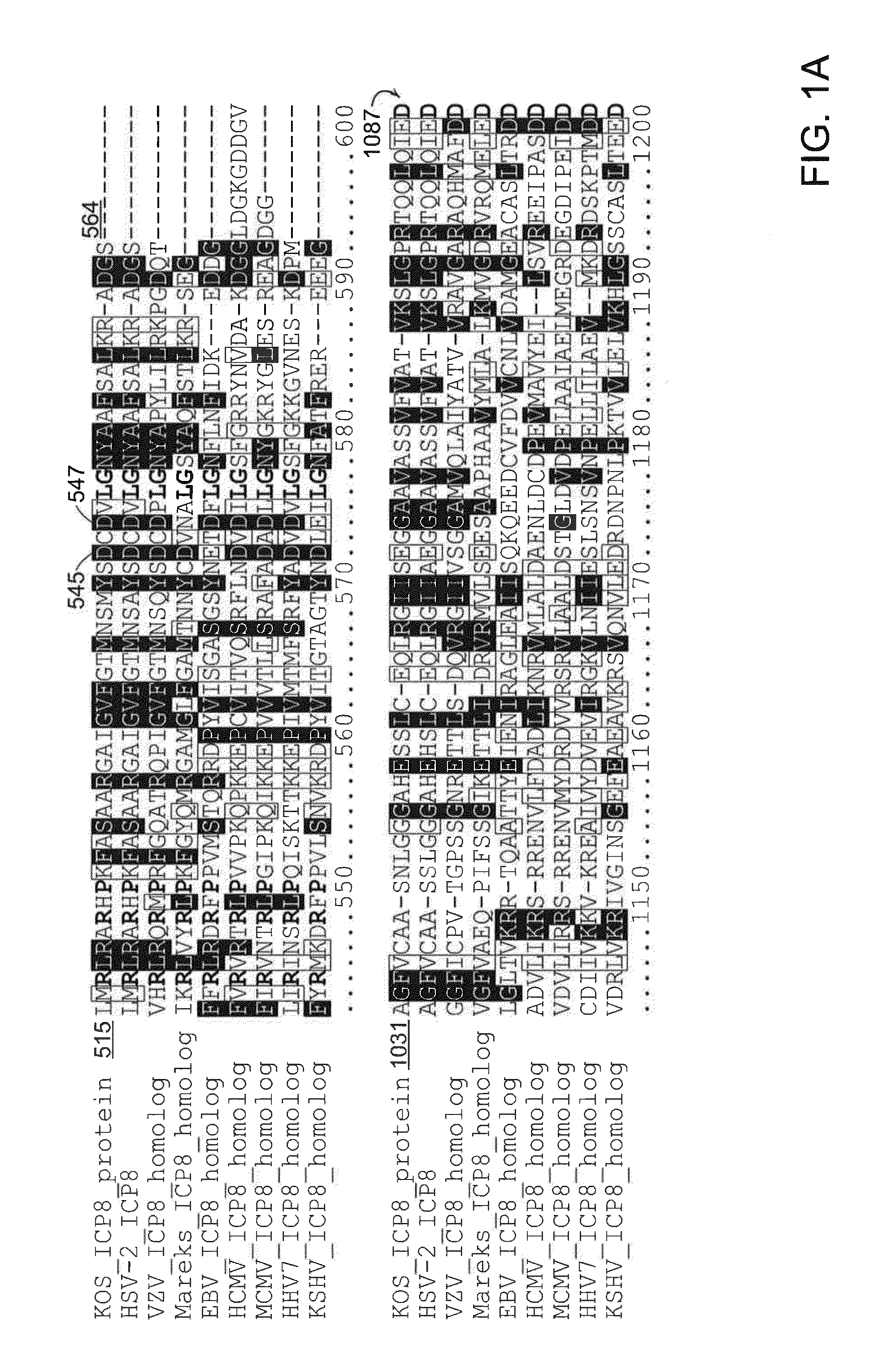Compositions and methods for treating herpes viruses
a technology for herpes viruses and compositions, applied in the field of compositions and methods for treating herpes viruses, can solve the problems of reducing immune function, lifelong latent infections, and largely ineffective public health measures to control the sexual transmission of the virus, so as to reduce viral replication and reduce herpes virus replication
- Summary
- Abstract
- Description
- Claims
- Application Information
AI Technical Summary
Benefits of technology
Problems solved by technology
Method used
Image
Examples
example 1
ICP8 with Variations of the DDE Residues have Decreased Ability to Complement Replication of an ICP8 Mutant Virus
[0222]To identify highly conserved regions (and therefore new functional domains) in HSV-1 ICP8 and its homologs in other herpesviruses, an alignment of amino acid sequences from nine ICP8 homologs was performed, with representatives from alpha-, beta-, and gamma-herpesviruses. Numerous aspartic acid (D) and glutamic acid (E) residues were identified that were conserved in many or all of the ICP8 homologs (FIGS. 1A and 1B). The conservation of these residues in the homologs suggests that they are important for ICP8 function. Several of these conserved residues were located in or near the DNA binding groove in the ICP8 crystal structures (Mapelli, M., et al., J. Biol. Chem., vol. 280, pages 2990-2997), suggesting that they would be available to carry out enzymatic functions on bound DNA. Interestingly, members of a family of enzymes called DDE recombinases, including trans...
example 2
The DDE Residues in ICP8 are Required for HSV-1 Replication and Viral DNA Replication
[0227]KOS.DDEm, a mutant virus containing the E1086A / D1087A mutation in ICP8, was constructed to investigate whether this mutant form of ICP8 affected HSV-1 replication when expressed from the viral genome. As shown in FIG. 4A, replication of this mutant virus was indistinguishable from the ICP8-null virus 8lacZ in non-complementing Vero cells. KOS.DDEm replicated to nearly wild type levels in the complementing V529 cells, suggesting that while this DDE mutation in ICP8 cannot support viral replication, it does not have a dominant negative phenotype, which is different from the d105 mutation.
[0228]The levels of viral DNA replication in Vero cells infected with either the KOS.DDEm mutant virus or wild type KOS were investigated. No viral DNA replication was observed between 4 and 12 hours post infection in cells infected with the KOS.DDEm mutant virus. In contrast, as shown in FIG. 4B, a more than 20...
example 3
Effect of DDE Residues on Viral Gene Expression
[0229]As described above, the KOS.DDEm mutant virus exhibited defects in viral replication and DNA replication; consequently, KOS.DDEm mutant virus was also tested for an effect on viral gene expression. The accumulation of the immediate-early gene products ICP27 and ICP4, the early gene product ICP8, and the late gene product glycoprotein C (gC), was assayed by performing immunoblot assays with Vero cells that were infected with either wild type HSV-1 or the ICP8 mutant virus KOS.DDEm. As shown in FIG. 5, slightly higher levels of ICP27, ICP4, and ICP8 were observed in KOS.DDEm-infected Vero cells, relative to Vero cells infected with wild type HSV-1, suggesting that the putative DDE recombinase residues in ICP8 are not required for expression of viral immediate-early or early genes. Although accumulation of the immediate-early and early gene products tested was not dependent on the DDE residues in ICP8, the late gene product gC was ob...
PUM
| Property | Measurement | Unit |
|---|---|---|
| molecular weight | aaaaa | aaaaa |
| body weight | aaaaa | aaaaa |
| temperatures | aaaaa | aaaaa |
Abstract
Description
Claims
Application Information
 Login to View More
Login to View More - R&D
- Intellectual Property
- Life Sciences
- Materials
- Tech Scout
- Unparalleled Data Quality
- Higher Quality Content
- 60% Fewer Hallucinations
Browse by: Latest US Patents, China's latest patents, Technical Efficacy Thesaurus, Application Domain, Technology Topic, Popular Technical Reports.
© 2025 PatSnap. All rights reserved.Legal|Privacy policy|Modern Slavery Act Transparency Statement|Sitemap|About US| Contact US: help@patsnap.com



